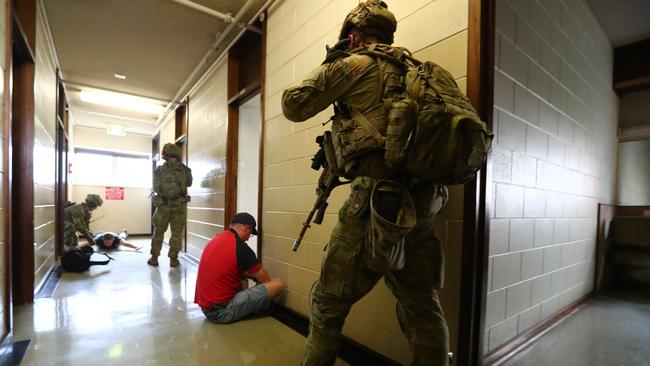Old Royal Adelaide Hospital gets a new life — as a military urban assault landscape for staging drills
THE old RAH is besieged by soldiers, its ageing corridors turned into an urban assault landscape for the Army and Air Force to test their technology against mock enemies.
SA News
Don't miss out on the headlines from SA News. Followed categories will be added to My News.
URBAN “warfare” came to Adelaide today as military forces stormed part of the old Royal Adelaide Hospital, capturing hostiles and freeing hostages in a mock drill designed to test new technology.
More than 100 Army and Air Force personnel, backed by 80 researchers, were involved in the dramatically realistic scenario where opposition forces had seized a “data centre” — the multistorey old nurses accommodation block.
Soldiers in full camouflage gear carrying unloaded assault rifles and high tech communications equipment surrounded the building then entered through several points including a tunnel, moving floor by floor and room by room to mirror city fighting.

Waiting officials and media who earlier had been joking quickly went silent as deadly serious armed soldiers arrived on our floor, barking orders and following well-drilled search-and-secure plans.
Cries of “help” as well as various obsenities rang out as the soldiers moved room by room finding militants, hostages, civilians and “unknowns” — people claiming to be hostages but who may be the enemy.
Competence, coolness and confidence were some of the hallmarks of the soldiers leading the charge into the unknown — but part of the drill was to unmask some of that unknown before they charged.

The Contested Urban Environment Strategic Challenge (CUE Adelaide 17) is a five nation defence technology field activity.
Officials say urban warfare is a growing challenge for Australian forces serving overseas and the use of new and emerging technology to give military personnel an edge can reduce risk to them and to civilians.
The same technologies can be used in urban terrorism situations.
Technology being tested in the exercise which runs until December 1 includes airborne and ground sensors, the sort of “eyes in the sky” and “nose to the ground” seen on TV and the movies, according CUE Adelaide chief scientist Dr Justin Fidock.

While most such exercises are conducted on military bases, the use of the old RAH — a vast collection of buildings in a genuine urban environment — is an “unprecedented opportunity” for realism, he said.
“Integration of air and ground sensors can give the military much more timely information, so they can respond quickly to threats and reduce threats to themselves and to civilians,” he said.
“You’ve probably seen things on TV and in the movies — drones with a camera that can take a wide angle view and also really zoom in, and little cameras hidden inside a little casing on the ground.
“It’s all about identifying promising technology we can put into their hands.”
Australian National Representative for CUE Adelaide, Dr Lin Zhang said some of the emerging technologies might be several years away from full development.
Participating nations are the “Five Eyes” group of Australia, New Zealand, Canada, the UK and US, and while most activity will be out of public view, some participants in camouflage clothing and carrying equipment may be seen in the vicinity of Frome Rd near the old dental hospital for the next week.



